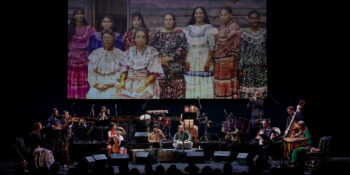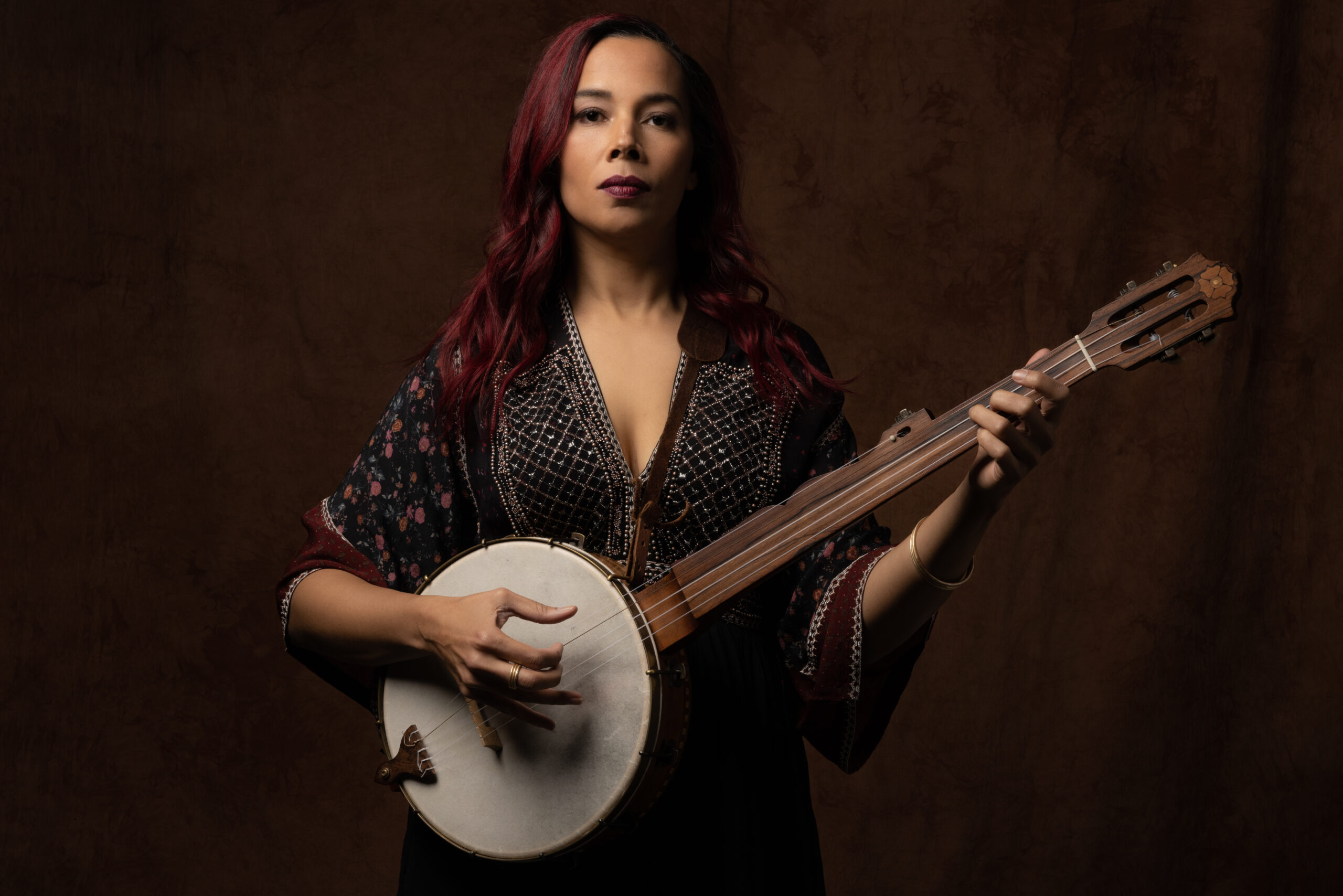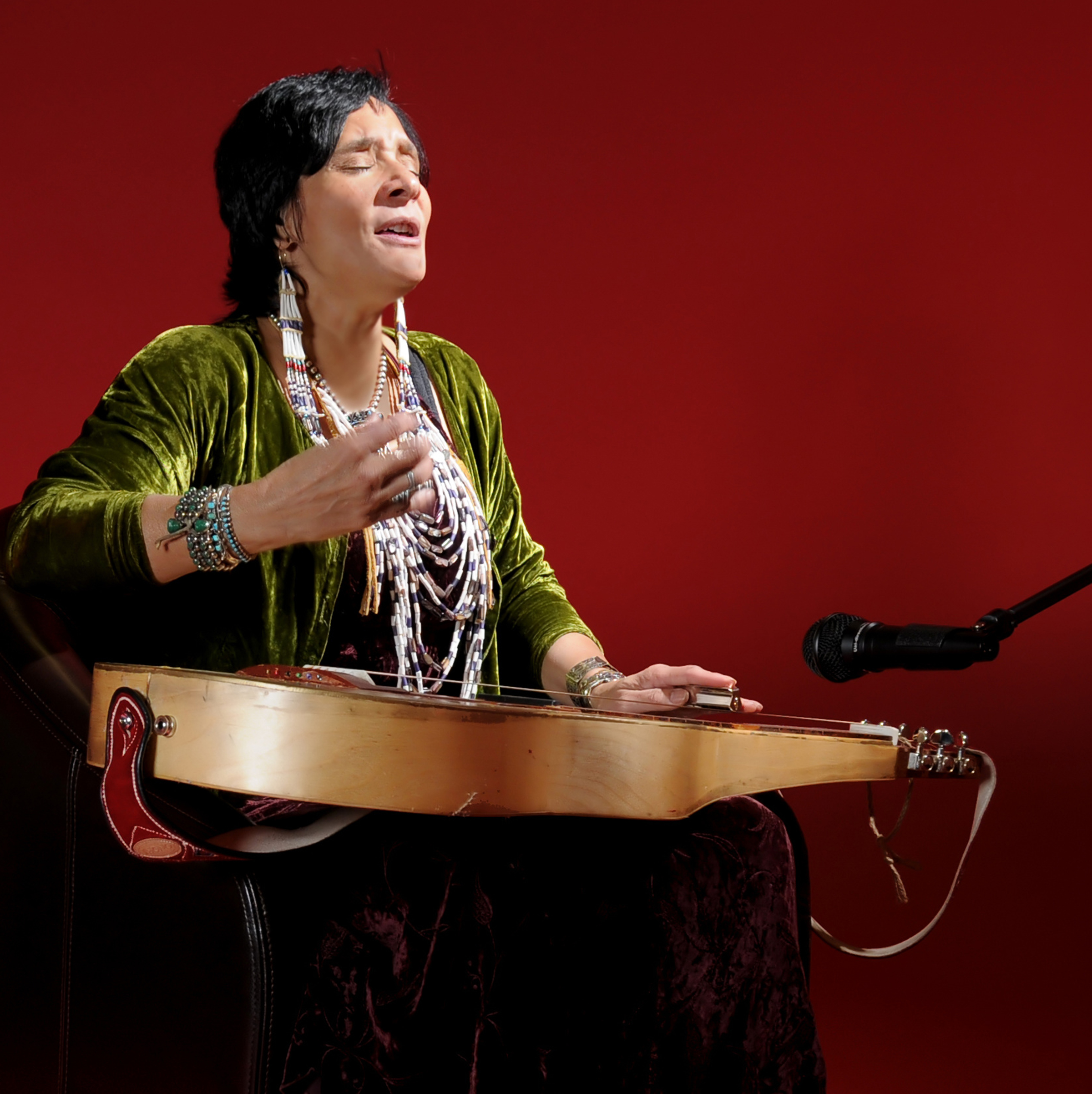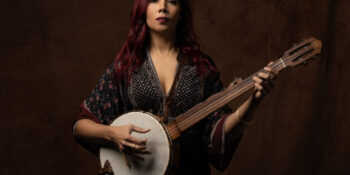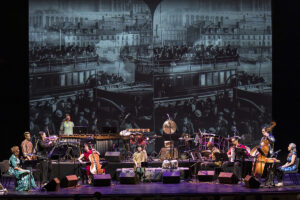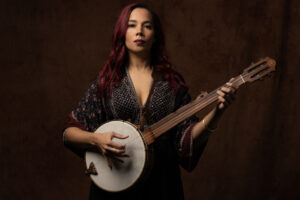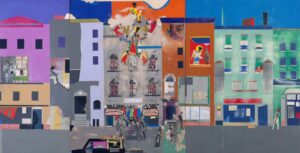The MCR Interview
Violinist Frederik Øland of the Danish Quartet
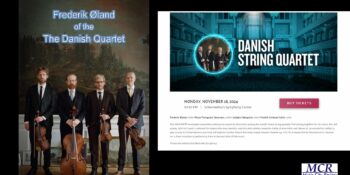
Music City Review Journalist Jayna Powell interviews violinist Frederik Øland on his work, touring and upcoming performance in Nashville at the Schermerhorn.
Women in Theatre’s Topical Political Play: What the Constitution Means to Me

Women in Theatre (WIT) Nashville have chosen a perfectly topical play for November in an election year: Heidi Schreck’s What the Constitution Means to Me. It was a 2019 finalist for the Pulitzer Prize for Drama, had a limited run on Broadway, and a video recording of the play is available on Amazon Prime as well.

Going into the show I wondered if it would hold my attention; I love history, but I’ve never been particularly interested in our founding documents or legal system (except for when I was ten and National Treasure came out). The play did hold my attention and sparked curiosity. The writing is entertaining and interesting. Historical anecdotes and mentions made me curious to learn more; besides learning more about each amendment, I now want to learn more about Asa Mercer shipping women from the east coast to Seattle, historical legal restrictions against prosecuting men who abuse their wives, the history of access to contraception, and more. Educationally, toward the end of the show pocket constitutions were handed out.
The play is personal, the playwright Heidi Schreck having originally played the starring role. The script has been slightly tweaked for performances with other actresses playing the role, as is the case here in Nashville. There are two acts. In the first Heidi speaks to the audience about her 15-year old self, who toured American Legion halls across the US in 1989 to earn money for college by competing in debates and giving speeches about the constitution. Sometimes she is her present-day self, a middle-aged woman, and sometimes she’s acting as her teenage self. The legionnaire who moderates the speeches in her memories changes character partway through to a version of Heidi’s real-life friend, becoming Mike, a gay man who discusses his experience of social pressure and violence over his sexual identity.
The second act is much shorter, being a debate then a Q&A between Heidi and a teenager. The debate is over whether we should keep or abolish the constitution. In the original play, this teenage debater alternated between several different local high school students and the debate was unique to each performance. In WIT’s show this role is played by the same teen each performance. After the debate, a member of the audience gets to choose whether to keep or abolish the constitution. I saw the show November 9th, and a coin flip determined that Heidi argued for keeping and the teen argued for abolishing the document. The audience member chose to keep the constitution, and so we got to keep our pocket copies of the constitution (my sister and I were hyped about this). The debate was interesting and we were encouraged to be vocal, cheering or booing when points were made. I understand why the playwright chooses to debate a high schooler in this play, but it makes the debate slightly lopsided: an adult has such an advantage over a teenager.
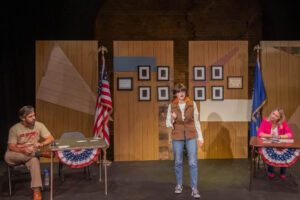
The big focus of the play, told through both discussions of the constitution and through topical personal stories, is the place of women in the document. The great focus is on the 14th Amendment; I was rather surprised that so little time was spent on suffrage or Roe v. Wade, but the influence of the 14th amendment is incredibly influential in so many following cases, especially ones involving civil rights. Time is spent clarifying the difference between negative and positive rights, the conclusion of the play being that we have far too few positive rights, and that changes should be made. This woman-focused view of the constitution makes Mike’s personal monologue feel somewhat out-of-place. Possibly his story is to emphasize the presence of heterosexual male violence throughout history, or to give a brief non-female view. While well-written and very well delivered, I did have to wonder what difference it would make if this segment had never been part of the show.
The play uses a few historic audio clips to emphasize various points. After a discussion of legalized abuse through history, we hear a clip from the 2005 supreme court case of Town of Castle Rock v. Gonzales. A woman sued the police after they refused to respond to the kidnapping of her three daughters, who were then murdered. The audio clip from that trial has two justices discussing whether or not the word “shall” meant “shall,” before ruling against the woman. Showing such callous quibbling in this tragic case is impactful. Another clip, from Griswold v. Connecticut, the 1965 case discussing the legality of birth control, is highly entertaining, the brief clip ridiculously full of embarrassed coughs as the elderly men awkwardly discussed contraception. Other than these and a few other audio clips, there is no music.
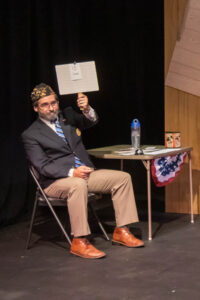
Since WIT is performing this at the Darkhorse Theater, an intimate space, they don’t use microphones for the performance. I appreciate this choice by Director Abby Waddoups: instead of the inevitable auditory awkwardness of unnecessary microphones, the actors project so naturally that it wasn’t until halfway through the performance that I even noticed the sound quality.
The set design is good and simple, an amalgamation of different Legionnaire halls from Heidi’s past. There are a few tables and chairs, a podium, wood-paneled walls with some photos and decorations. The costumes are fitting. Heidi wears two different public-speaking outfits, the teen dresses as a contemporary teen, and the gray-haired legionnaire wears a suit and hat, which he removes when he changes character to Mike, finally standing before us in his pants and an old Led Zeppelin T Shirt. His natural dark hair is revealed when he removes his hat, so his gray beard and temples form a fitting contrast to the hidden color.
Lindsey Patrick-Wright plays Heidi. The sheer amount of non-stop lines she delivers is impressive: I think in the duration of the play she speaks more than the average person speaks in several days. Her voice is strong and well-projected, and she maintains energy the entire time. Sometimes the role is conversationally personable, sometimes distraught, joking or solemn, and Patrick-Wright does well through it all. Thomas Wehby plays the Legionnaire/Mike, and his kindly older man persona is quietly funny and contrasts well with his vulnerability and intimacy as Mike. Pippy Patrick-Wesson is the teen debater and Lindsey Patrick-Wright’s real-life child. Their role doesn’t require an acted persona, but uses their own personality and words for the debate, revealing an outgoing and confident personality.
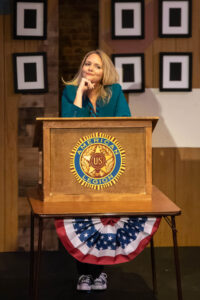
I left the show with a deeper respect for the Constitution as a document, and for all the incredible effort that has gone into amending the document for the better. I agreed with that night’s audience that we should keep the document. As Patrick-Wright pointed out in the debate, why would we trust our current politicians and lobbyists to do a better job? Necessary improvements should be future amendments. Agree or disagree with statements in the show, you’ll be intellectually stimulated and given a new appreciation for America’s legal documents and the battle made over them. As an Independent I find neither of our two major parties have a platform I can fully endorse, and just as I’d expected, the play is written from a liberal viewpoint and assumes that the audience fully agrees. However that assumption isn’t expressed in a malicious or contemptuous manner, which is quite refreshing in our current polarized climate.
WIT is a new organization and the night I attended had an undeservedly small audience. As more people learn about them and they continue to give well-chosen and well-performed productions, I expect their audience to grow!
This play was chosen to occur right after an especially tense presidential election. I doubt any attending the show had voted for Trump or hoped for his win. Mentions of the results were made in passing before the show, but there were no added remarks about him. At the Q&A at the end, an audience member wondered what we’re supposed to do after this election’s results. Linsdey Patrick-Wright responded by saying that we always have hope. She said that she’s been accused this week of being “cozy.” Her response to the idea that angry despair is somehow stronger or more virtuous than hope is wise: “Hope isn’t cozy. Hope is fire.”
WIT will perform What the Constitution Means to Me through November 16th at the Darkhorse Theater. For tickets and more information, see Women In Theatre Nashville.
The MCR Interview
Librettist Mark Campbell on ‘The Cook-Off’
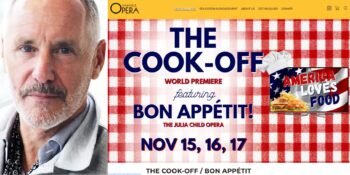
Music City Journalist Andrew Davis interviews Grammy and Pulitzer Prize winning librettist Mark Campbell on the coming premiere of his new opera The Cook-Off with Nashville Opera. Topics covered include macaroni and cheese, comedy and opera, collaboration, and history.
Día de Los Muertos
Art, Memory, and Awareness in the Gardens of Cheekwood
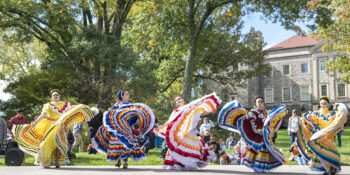
Versión en español aquí
Cheekwood Estate & Gardens is celebrating the 25th anniversary of its Día de Los Muertos festival! Since 2000, this grand event has brought the Latino community together in a space where they can reconnect with their roots through dance, art, music, and gastronomy. The project began with a program of activities lasting five hours, but as it gained recognition, it expanded to two full days of celebration. This festival is one of the most anticipated events in the metropolitan area and has encouraged Nashvillians to engage actively with foreign cultural expressions. Visitors from various cultures often wear attire inspired by Día de Los Muertos or have their faces painted by the festival’s artists.
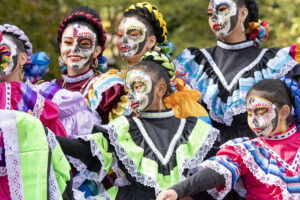
The program offers a rich and varied selection of folkloric music and dance projects, mostly from Mexican traditions. Some featured groups included Danza Azteca Guadalupana, Lirios Folklóricos, and MNPS Ballet Folklorico Dance Group. Another highlight worth mentioning is the participation of public schools, which promote cultural diversity. Alongside dance activities, students also contribute by creating murals and decorating altars. For example, in the Frist Learning Center Great Hall, a colorful exhibition of artworks inspired by Día de Los Muertos showcased a blend of Mexican and Tennessee traditions. Two works that caught my attention in this multicultural fusion were a mural created by Bellevue Middle School, which represented an altar inside a wooden cabinet within a home adorned with picture frames featuring album covers from bands such as The Beatles, Nirvana, and Led Zeppelin. The faces of deceased band members were covered with calavera-style illustrations. The second mural, created by Hendersonville High School, portrayed the faces of Hank Williams, Minnie Pearl, Loretta Lynn, Patsy Cline, and Johnny Cash in a composition that combined elements shared between country and Mexican music, such as guitars.
In the altar exhibition, the schools also gave a significant twist to this tradition. Paragon Mills Elementary recreated the improvised shelter of a homeless person with a reused cardboard sign that read “Housing Now.” The altar was covered with calaca drawings made by children, representing the controversial statistic of people who die while experiencing homelessness in Nashville. Aventura Community School crafted a more authentic and traditional altar to highlight the pillars of its institution, which focus on forming bilingual students in English and Spanish. The Metropolitan Police Department also participated with its Family Intervention Program division, presenting an altar filled with portraits of Latino community members who had lost their lives under various circumstances of violence.

The cultural and Latin American organization Misión ConArte also had a significant presence at this festival. In addition to creating an altar showcasing artworks from its members, they were in charge of the Catrina Parade. The runway was a display of different elements representing Mexican culture. Each model incorporated a special theme into their attire, revealing the richness of their country through the iconography of José Guadalupe Posada’s Calavera Garbancera. Some of the figures included the Quetzalcoatl, the monarch butterfly, traditional Mexican dolls, and the quinceañera. Each outfit was adorned with harmonious and creative details, with meticulous designs on the skirts and three-dimensional structures on the torso or head to create a more striking effect.
After this demonstration, the first three jackets of an artistic project were showcased, aiming to represent the essence of each nation through fashion. The displayed pieces represented Honduras, Mexico, and the United States and were created by artists native to these countries. The jackets were like walking paintings, full of color, genuinely representing the beauty of these territories.
The sense of taste was not left out of this sensory celebration. A gastronomic corridor offered the traditional flavors of Guatemala, Peru, Venezuela, Colombia, Mexico, and Argentina, making it difficult for attendees to choose among so many delights. In this food section, there was also a stage where groups performed classics of salsa, bachata, and cumbia, creating the perfect atmosphere for a complete immersion in the spirit of a festival from any region of Latin America.
A Día de Los Muertos celebration like this is not only about honoring the memory of those who are no longer with us but also remembering who we were, the Latinos, when we lived in our homeland.
Día de Los Muertos
Arte, Memoria y Conciencia en Los Jardines de Cheekwood

English Version Here
¡Cheekwood Estate & Gardens celebra ya su 25° aniversario del festival del Día de Los Muertos! Este gran evento ha reunido a la comunidad latina desde el año 2000 en un espacio donde es posible reencontrarse con sus raíces a través de la danza, el arte, la música y la gastronomía. El proyecto inició con un programa de actividades dentro de un lapso de cinco horas y conforme a la notoriedad que fue ganando, se ha extendido a dos días de celebración. Este festival es uno de los eventos más esperados en el área metropolitana y ha promovido en los nashvillianos el interés de acercarse activamente a expresiones foráneas. Asistentes de varias culturas procuran llevar un atuendo alusivo al Día de Los Muertos o acceden a maquillarse con los artistas del festival.
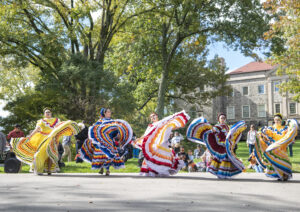
La programación ofrece una rica y variada oferta de proyectos de música y danza folklórica en su gran mayoría de tradición mexicana. Por mencionar algunos están las agrupaciones Danza Azteca Guadalupana, Lirios Folklóricos y MNPS Ballet Folklorico Dance Group. Este es otro gran evento que hay que destacar, la participación de las escuelas públicas que promueven la diversidad cultural. Junto con las actividades de danza, los estudiantes también participan en la creación de murales y en la decoración de altares. En el Frist Learning Center Great Hall, por ejemplo, se extendió una colorida exhibición de obras artísticas alusivas al Día de Los Muertos, que incorporaron la tradición mexicana y de Tennessee. Dos obras que llamaron mi atención en esta fusión multicultural, fueron el mural creado por Bellevue Middle School que representaba un altar sobre una especie de mueble de madera al interior de una casa, y en el reposaban portarretratos con las portadas de álbumes pertenecientes a bandas como The Beatles, Nirvana y Led Zeppelin. Los rostros de los integrantes que ya fallecieron estaban cubiertos con el dibujo de una calavera. El segundo mural elaborado por Hendersonville High School retrató los rostros de Hank Williams, Minnie Pearl, Loretta Lynn, Patsy Cline y Johnny Cash en una composición que combinaba elementos en común como las guitarras en la música country y mexicana.
En la exhibición de altares, las escuelas que participaron le dieron también un giro significativo a esta tradición. Paragon Mills Elementary recreó el improvisado techo de una persona sin hogar con un cartel de cartón reutilizado que decía “Housing Now.” El altar estaba tapizado de dibujos de ‘calacas’ elaborados por los niños y que representaban la controversial estadística de personas que mueren en Nashville por vivir en condición de mendicidad. Aventura Comunity School elaboró un altar con un estilo más auténtico y tradicional para promover los pilares de su institución que se enfocan en la formación de estudiantes competentes en las lenguas del inglés y el español. La Policía Metropolitana también estuvo presente con su división Family Intervention Program, con un altar repleto de retratos de las víctimas de la comunidad latina que han perdido la vida en diferentes circunstancias de violencia.

La organización cultural y latinoamericana Misión ConArte tuvo también una participación importante en este festival. Además de elaborar un altar con las obras de arte de quienes hacen parte de este proyecto, estuvo encargado del desfile de Catrinas. La pasarela fue una exhibición de diferentes elementos que identifican la cultura mexicana. Cada modelo incorporó en su vestido una temática especial que revelaba la riqueza de su país por medio del lenguaje iconográfico del personaje de la Calavera Garbancera de José Guadalupe Posada. El Quetzacoátl, la mariposa monarca, las tradicionales muñecas mexicanas y la quinceañera, fueron algunos de las figuras que desfilaron. Cada traje incorporaba con armonía y creatividad minuciosos detalles en la falda y estructuras en el torso o en la cabeza para darle un toque tridimensional mucho más atractivo. Luego de esta demostración desfilaron las primeras tres chaquetas de un proyecto artístico que busca representar la esencia de cada nación a través de la moda. Las piezas que se pudieron observar pertenecían a Honduras, México y EEUU, y fueron elaboradas por artistas nativos de estos países. Las chaquetas eran cuadros andantes llenos de color representando genuinamente la belleza de estos territorios.
El gusto no quedó fuera de esta celebración sensorial. Un corredor gastronómico ofreció los sabores emblemáticos de Guatemala, Perú, Venezuela, Colombia, México y Argentina, desafiando a los asistentes a elegir entre tantas delicias. En esta sección de comidas se ubicaba también una tarima en la que agrupaciones interpretaron clásicos de la salsa, la bachata y la cumbia, creando el ambiente perfecto para una inmersión total en el espíritu de un festival de cualquier región en Latinoamérica. En una celebración de El Día de los Muertos como esta, no solo se conmemora el recuerdo de quienes ya no están en el plano terrenal, sino el recuerdo de quiénes éramos nosotros, los latinos, cuando vivíamos en nuestro hogar.
From Page to Stage: Literary Characters in Belmont’s Opera Scenes
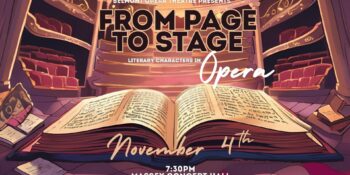
On Monday November 4th, Belmont University performed their Opera Scenes production in the Massey Concert Hall. It centered around six scenes all from operas based on stories or books. Before the show, director Dr. Savanna Sokolnicki explained the hard work and incredible talent of the students. She also shared the tricky aspects of creating an opera scenes program with the selection of music including vocal accessibility for collegiate students and the best music in opera being represented. Dr. Sokolnicki and music director Daniel Krenz accomplished this very well. The production combined the classic stories we grew up with, the lessons we can gather from them, and the great parts of opera.
The show opened with two students in a library browsing books on two large bookcases (graciously donated to the University by Habitat for Humanity). They began chatting about their favorite stories growing up and took turns choosing books. Each time they opened a book, the scene from that opera began signifying how we are seeing the story play out as they are reading it. I enjoyed how this played with the fourth wall mixing fantasy with real life.
The first story was derived from a novella by Rudolf Těsnohlídek called “The Cunning Little Vixen.” It was adapted into an opera by the Czech composer Leoš Janáček (1854-1928). A young vixen named Sharp-Ears, played by Paige Padgett, entered with an ornate, red fox costume and eye mask provided by Lissa McHugh of BRAVO Theatre. She met a young fox named Gold-Stripe in matching attire, played by Grace Homer, and they fell in love. The chemistry was great between the two, but the highlight of this scene was the music itself. Along with all the text being sung in Czech, there were very complex rhythms and overlapping parts between the two vocal lines. Pianist Laura Benavides acted as a one-woman orchestra with a highly active piano part that she masterfully played. The charming scene continued with the ensemble coming out as many different animals portraying animal life as the two foxes get married. The whole cast posed for a cute animal family photo to end the scene.
The next book read also involved a fox, but this story was the 1943 novella “The Little Prince” by Antoine de Saint-Exupéry, which was adapted into an opera by Rachel Portman (b. 1960). This scene opens with mischievous piano accompaniment as a group of uncoordinated hunters in safari gear march out in a Rockettes-style line. In this scene, the hunters are attempting to catch a wild fox, played by Claire Tole, but are unsuccessful. This chase sequence felt like a classic Tom and Jerry episode as the hunters fail to catch the fox. The comedic timing and choreography were very charming with the hunters using binoculars to look up in the sky as the fox runs right in front of them. The scene then moves to a young prince, played by Jiana Kevilus, meeting the same wild fox. The fox is enamored by the boy asking if he will tame him because he wants to be a special fox. Jiana’s lovely, bright voice paired with the charismatic, funny interpretation of the fox created a great sense of friendship and love between the two. Along with some impressive coordination and hopscotch choreography, this scene was endearing and reminded us of why we love classic children’s stories.
The transition to the third scene included a new friend walking into the library as the two girls are gabbing about “Little Women” written by Louisa May Alcott. He then proceeds to chime in confusing “Little Women” with “Honey I Shrunk the Kids” in a hilarious exchange between the three. As the dialogue ends, the music for the opera written by Mark Adamo (b. 1962) begins. The four sisters Amy, Jo, Beth, and Meg, played by Izzy Kohler, Angela Stenzel, Megan Calgaro, and Val Haas respectfully, all enter in Civil War era costumes along with Laurie, played by Chase Lowery (who we will see more of later). The scene centers around the sisters making a game out of folding laundry with the slowest person having to answer three personal questions. The modern music itself had very complex four-part harmony with the piano hardly helping the singers. The musicianship was great, especially with the intricate acapella section where the voices truly shined. Angela Stenzel was a standout in this number as Jo with her warm, rich mezzo register leading the sisters.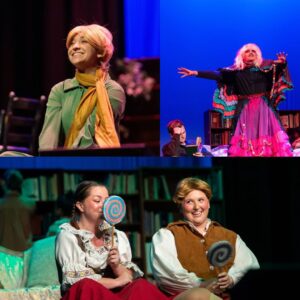
The next scene that was chosen is one of the most famous scenes in opera history. It is from “Carmen,” originally an 1845 novella by Prosper Mérimée, but made famous by Georges Bizet (1838-1875) and his iconic opera. The scene chosen was the tarot card scene where Roma gypsy Carmen, played by Kat Witkowski, and her two friends Frasquita and Mercedes, played by Anna Cannito and Bridgett Baker, drew tarot cards to see their future. Frasquita and Mercedes saw great futures with love and wealth represented by the joyful, bouncy melodies sung by the two. Carmen, in a gorgeous red Spanish dress, drew death every time as her fate. The sultriness of Carmen’s voice complemented by the active soprano lines of Frasquita and Mercedes made this scene one of the high points of the whole night.
My favorite scene from the night was the selection from Gounod’s “Roméo et Juliette” (1818-1893) based on the Shakespeare play. Benavides opened with a fast, intricate Chopin-like passage as Frere Laurent, Romeo, and Juliette entered on stage played by Skylar Peterson, Javi Castro, and Abby Orr respectively. Frere Laurent married the two young lovers in secrecy as Juliette’s maid Gertrude, played by Claire Tole, stood guard in the church. Javi Castro as Romeo and Abby Orr as Juliette were so incredible to watch. Romeo’s warm tenor voice complemented Juliette’s bell-like tone and created a beautiful blend that truly felt like two becoming one. Their stage presence and chemistry together combined with Benavides’ playing and Krenz’s conducting made this the highlight of the night.
The last two scenes in the show had one common theme interpreted in different ways: witches. The first scene was an adaptation from Shakespeare’s play “Macbeth” by Giuseppe Verdi (1813-1901). The three witches that embody fate and manipulation are played by the female ensemble. The witches enter, moving as one mind and body, dressed head to toe in black with different colored head wraps. The creepy melodies combined with the spooky accompaniment was hypnotizing. Bloody props were thrown into a cauldron while the witches performed synchronized arm movements making this scene both musically and visually incredible.
The last scene took us back to the theme of childhood stories with “Hansel and Gretel” by the Brothers Grimm adapted into an opera by Engelbert Humperdinck (1854-1921). Hansel and Gretel, played by Angela Stenzel and Paige Padgett, first stumbled upon the Witch’s candy-covered house and began to stuff their faces. The comedic timing in this scene was great, especially when the Witch appeared for the first time. Chase Lowery, who played Laurie in the “Little Women” scene, played the Witch as a tenor role and completely stole the scene. He emerged in a sequin-covered two-piece with a bright pink skirt, a white wig, and glittery makeup. His presence was terrifying, but I could not keep my eyes off of him. At the end of the piece, the readers in the library walked out and one picked up a cartoon-sized lollipop, signifying how reality and fantasy are now blurred.
Overall, Belmont University’s School of Music put on a terrific production with so many talented students. The repertoire chosen complemented the vocalists, and it was so much fun to watch. Nowadays, it is more important than ever to have something that makes you escape reality for a bit, and that is exactly what this production accomplished.
Shucked: Corny Fun

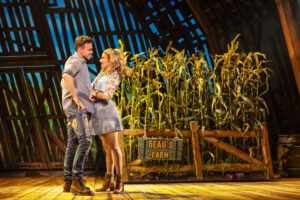
Shucked is a 2022 Broadway musical comedy which ran until January this year. Its North American tour began in October and is planned to travel through September of next year. A feature film is also in the works. The plot is simple and familiar: think along the lines of A Bug’s Life and The Music Man. A remote rustic town comes into trouble; their ever-important corn harvest is suddenly drying up, a calamity so sudden and unexpected that it halts the marriage of young Maizy and Beau mid-ceremony. They can’t find a solution, so Maizy decides to leave the town and find help, to her fiance’s disapproval. She travels to exotic and glamorous Tampa and comes across a down-and-out con man (Quinn VanAntwerp) posing as a podiatrist: his sign says “Corn Doctor.” Upon seeing the valuable material her homemade bracelet is made out of, he resolves to go back with her, steal the rest of the valuable stones, and use the money to pay off his debt to a mobster. You can see where the rest of the story will go. However, the unoriginal plot is no issue to the success of the show: it’s a light comedy, not a drama. Anyways, we all love mistakes and redemption, and plots that focus on this remain fresh, just as instant-karma traffic videos provide perennial satisfaction (especially if you live in Antioch). There’s no deep message to the show, but it doesn’t need one because the heart of the show is laughter. I saw the November 6th show at TPAC and the hall was full and the audience was engaged. It was fun to hear belly laughter rolling through the audience after each joke landed.
Shucked is absolutely full of corny puns (that’s deliberate) and one-liners. So many one-liners. Some of them are completely off topic: one character, Peanut (Mike Nappi) will halt the dialogue to deliver random, unrelated jokes to the audience. At first the number of asides and one-liners from everyone felt distracting and unnecessary, but the sheer volume of jokes means that enough land that you laugh and hope for more. Some are delightfully witty: “Marriage is simply two people coming together to solve problems they didn’t have before.” Some are unexpected, “No Grandpa, a grave mistake was burying Grandma on a slope,” and some are plain weird, “I just passed a huge squirrel, which is odd, because I don’t remember eating one.” If you like the Marx brothers, Mel Brooks, or Airplane! then you’ll probably enjoy the humor.

The characters are likable enough, each growing in their own way. My favorite characters are the two storytellers (played by Maya Lagerstam and Tyler Joseph Ellis), who are a delightful use of live theater’s flexible artificiality. They narrate the show and even adopt roles to interact with the characters. Both actors are charming and work well as a comedy duo. Another great role is Lulu, played by Miki Abraham with a great worldly-wise attitude and sensuality that somehow blends easily with her kindness and love for remote Cob County.
The music isn’t amazing, but Brandy Clark and Shane McAnally’s lyrics are hilarious. Most of the songs are upbeat and fun Broadway ensemble numbers. Danielle Wade as Maizy has a strong voice and leads in many of them, “Travelin’ Song” being my favorite of hers. The two songs that left the greatest impression on my husband and I were “Somebody Will,” and “Independently Owned.” The first song feels like a familiar country breakup song (Beau is reacting to his break up with Maizy), showing off Jake Odmark’s superb Broadway voice. The second song is sung by Lulu, displaying her independent spirit. Abraham’s voice is fabulous and the catchy song has gotten stuck in my head. The choreography mainly focuses on the comedy elements of the show (such as a corncob kickline) and is good. Everyone is well cast.
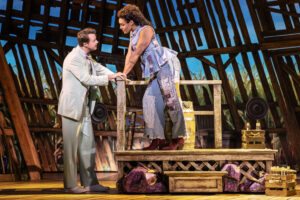
The set is fun and wonky: an askew wooden frame frames the stage, with a backdrop of corn seen through the wide slats of a leaning barn. Rustic barrels, beams of wood, walls, and wood flooring are all a warm brown. This color choice prevents the stage from feeling drab or rustically depressing. The set never moves and location changes are primarily shown by moving barrels, corn, or other props around.
I’d recommend seeing the show. It’s a lot of fun. Just bear two things in mind: with all the corn puns and references, whiskey is quite prominent, and you’ll be wanting a glass of bourbon by the time you leave. And while most of the innuendo will go over kids’ heads, there are a few jokes that could lead to conversations you don’t plan on having in a crowded public place (including one emphatic line of dialogue with the word “orgasm”).
Shucked is at TPAC until November 10th. The remaining shows are almost sold out. For tickets and more information, see Shucked | TPAC®, and for more information about their North American tour, see Shucked.

